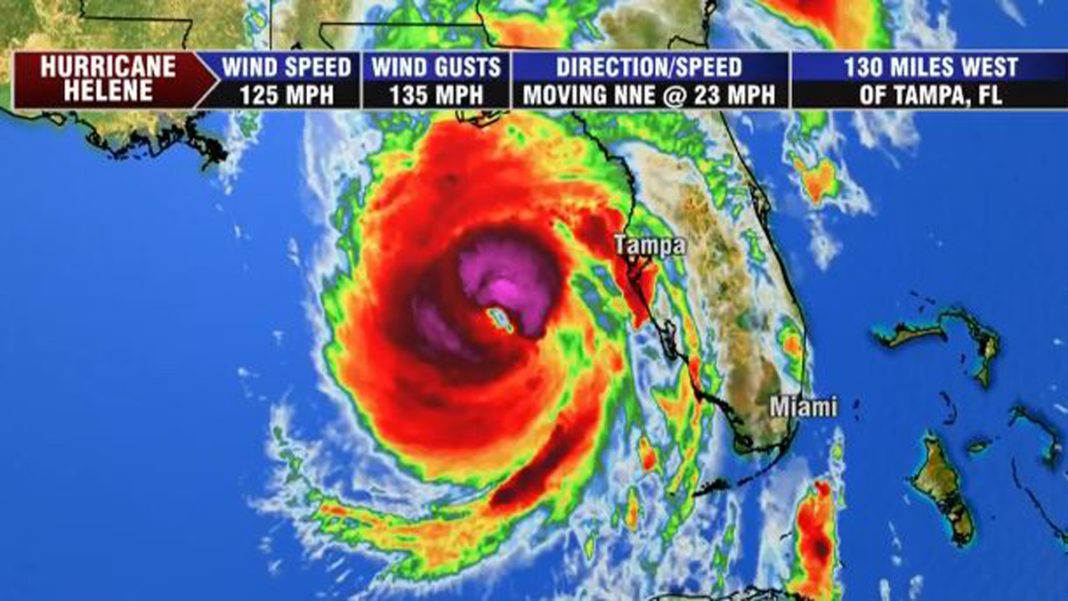As Hurricane Helene roared ashore in northwestern Florida late Thursday night, its formidable presence was felt across the southeastern United States. The storm, classified as a Category 4 hurricane with maximum sustained winds of 140 mph, made landfall around 11:10 PM EDT near the mouth of the Aucilla River, a region characterized by its picturesque fishing villages and natural landscapes. The National Hurricane Center in Miami warned that Helene could unleash a “nightmare” storm surge, with predictions of up to 20 feet in some areas, particularly in Apalachee Bay.
The scale of Helene’s potential destruction prompted emergency declarations from governors across multiple states, including Florida, Georgia, Alabama, and the Carolinas. Even before the storm made landfall, nearly 900,000 homes and businesses in Florida were left without power, highlighting the immediate impact of Helene’s powerful winds. Tragically, as the storm approached, two fatalities were reported in south Georgia, believed to be linked to a tornado spawned by the storm’s outer bands.
The National Weather Service had issued an “extreme wind warning” for the Big Bend area, urging residents to treat it like a tornado alert—advice that underscores the seriousness of the situation. “Take shelter in the most interior room and hunker down!” they advised, a reminder of the unpredictable nature of hurricanes and the dangers they pose.
Interestingly, Helene’s landfall comes just over a year after Hurricane Idalia wreaked havoc in the same region. Idalia made landfall as a Category 3 storm near Keaton Beach, causing significant damage with sustained winds of 125 mph. The recurring threat of severe weather in this region raises questions about the long-term resilience of communities that have already faced the wrath of nature.
In the face of the storm, many residents heeded evacuation orders, particularly in low-lying areas vulnerable to flooding. Sharonda Davis, a local resident, expressed her fears about the aftermath of Helene, stating, “The hurricane’s size is scarier than anything because it’s the aftermath that we’re going to have to face.” This sentiment reflects a growing concern among communities as they grapple with not just immediate dangers, but also the long-term implications of repeated severe weather events.
As Helene’s winds began to lash the coast, authorities were not only preparing for immediate rescue efforts but also for the potential of catastrophic flooding—forecasters warned that the deluge could produce rainfall amounts exceeding 14 inches in some areas. The National Oceanic and Atmospheric Administration has noted that this year’s Atlantic hurricane season is expected to be above average, driven by record-warm ocean temperatures, which contribute to the intensity of storms like Helene.
The storm’s impacts extend beyond Florida; heavy rains and strong winds were reported in Georgia, with some counties facing hurricane-force winds exceeding 110 mph. In a particularly harrowing moment, the Wheeler County Sheriff confirmed two fatalities due to a tornado that struck a mobile home, illustrating the deadly consequences of the storm’s peripheral effects.
In the larger context, Hurricane Helene is part of a troubling trend of increasingly severe storms that have been impacting coastal areas. According to Professor Marshall Shepherd, a meteorology expert from the University of Georgia, Helene could represent one of the most significant storms to impact a major Southern inland city in 35 years. This statement rings alarm bells regarding the escalating frequency and severity of hurricanes, which researchers attribute to climate change—an issue that demands urgent attention from policymakers and communities alike.
As authorities continue to assess the damage and implement recovery efforts, the resilience of Florida’s coastal communities will be tested once again. With schools, universities, and airports closing in anticipation of Helene’s wrath, it becomes clear that preparation and awareness are key to mitigating the impacts of such formidable storms. “Please take any evacuation orders seriously!” local officials pleaded, emphasizing that in the face of such natural disasters, the safety of residents must always come first.
As the storm moves inland, its effects will likely be felt well beyond Florida, with damaging winds and heavy rain expected to reach as far as the southern Appalachian Mountains. The potential for landslides and prolonged power outages looms large, reminding us all of the interconnectedness of weather patterns across regions.
In the wake of Helene, communities will need to come together to recover and rebuild, reflecting on the lessons learned from past storms. As history has shown, preparation and resilience are not just strategies; they are essential survival tools in the face of an ever-changing climate.

